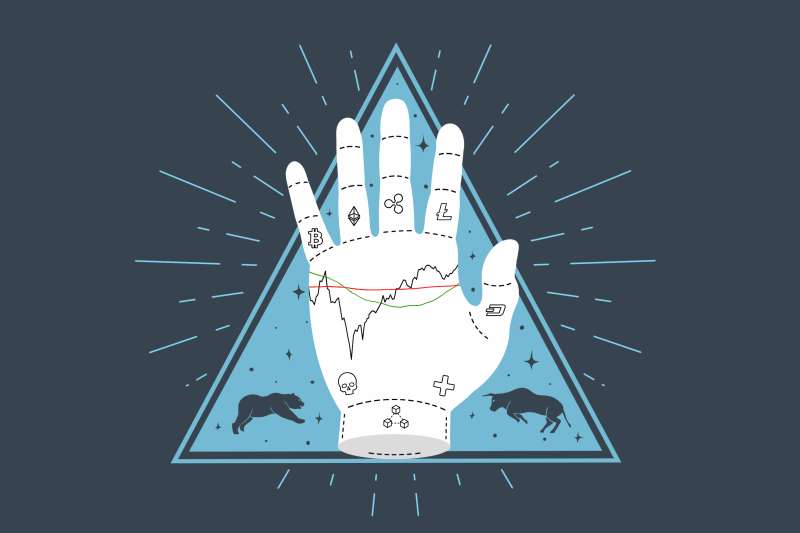
Many Bitcoin investors love looking at price charts and seeing the coveted ‘golden cross’. The ‘death crossing’, which is its dark counterpart, can also be a source of concern for YOLO-est investors.
Although cryptocurrency is relatively new, price charts are one of Wall Street’s oldest and most unusual trading strategies. It allows you to look for patterns in the up-and-down movements of prices. This controversial strategy is also the most debated. While some believe price patterns provide valuable information, others dismiss it as investing’s equivalent of astrology or tarot cards.
Strategists believe that Bitcoin market followers cannot ignore the hype surrounding a pattern on Bitcoin charts known as the “golden cross” regardless of their views on technical analysis. Talk about the indicator on specialist Web pages like CoinDesk or Cointelegraph could help to catalyze greater upward momentum, even if it is a self-fulfilling prophecy.
The trade of cryptocurrencies is ‘extremely technical’ because they don’t know what else to trade on. Mark Arbeter publishes a newsletter that analyzes the charts of various securities and indexes. “You cannot pick up an annual, quarterly, or any other kind of report and do a fundamental analysis.
What is charting?
Since Charles Dow’s 1884 publication of the Dow Jones Transportation Average, investors have been trying to find wider trends in financial markets. They chart prices and look for other indicators like trading volume and price movement averages. Technical analysts create trend lines on price charts based on these indicators in order to find turning points. These points can be broadly classified as:’support’ spots, where bounces are more likely to occur during selloffs; or’resistance’ spots, where rallies tend not to continue; or ‘breakouts’ and ‘breakdowns spots, where momentum should move in one direction.
Moving averages and momentum indicators are the most popular chart trends in cryptocurrency. They’measure the speed of either the up-trend, or the downtrend,’ says Arbeter. Arbeter. Moving averages can be either simple or exponential, with the former giving more weight to prices of recent years. The concept is simple: Take the daily price of a security, index or commodity over a specified period and add them all together. Divide by the number trading sessions.
Advertisements by Money. Click this ad to be eligible for compensation Ad
How the death cross/golden cross should work
Chart lines that track moving averages, which form the bullish “golden cross” and bearish “death cross”, trace the simple 50-day as well as the 200-day moving mean of a stock or cryptocurrency over a longer period of time.
Bitcoin recorded the “death cross” in July. This indicates that the short term trend, expressed as the 50-day moving mean line, had accelerated downward by crossing under the long-term trend line (the 200-day moving mean). This was supposed to signal a break in the long-term upward trend, which began in March 2020. As it turned out, Bitcoin started a new rally in July.
The bullish side is called the golden cross. It occurs when the 50-day moving mean breaks above the 200 day moving average. Bitcoin was just a few days away from a golden cross, as of Sept. 6, according to CoinDesk. The 200-day moving average was at $46,100, and the 50-day was close to breaking that mark after a string above $50,000. The second week of September saw Bitcoin prices fall. Technical analysts believe that this would be the first time the gold cross appeared on a bitcoin chart for more than a decade. This suggests a breakout to a more dramatic rally.
Is the golden cross actually worth it?
Arbeter, who started following stock charts on Wall Street in the week prior to the Black Monday, October 19, 1987, crash, said that there are many traders and algorithms that follow the Standard & Poor’s 500’s 200-day moving averages.
Arbeter says, “If you look back 100 years in time and see uptrends in major indexes, you will see that the 50-day worked back then…it is just something people pay attention too.”
Arbeter states that the indicators on the wild bitcoin chart are not as reliable. The July ‘death crossing’ marked an end to the downward trend and not an intensification.
The golden cross can still provide a reassuring signal for newcomers, according to Edward Moya (senior market analyst at OANDA), who specializes in foreign exchange. Charts have a lot of influence in this market. Moya sees a 50-day moving mean above 200-day as a sign that the short-term upward momentum has strengthened, decreasing the chance of a sudden crash.
Moya says that bitcoin is a place where you can see 20 percent plunges from nowhere and extreme drawdowns exceeding 50 the gold cross “relieves the concern that you’re trying catch a falling knife in one of those panic-selling frenzy frenzies.”
